Glistening Inkcap © Richard Bottle
Leader: Alan Rayner
Around twenty members arrived at Friary on a fine morning and were treated to coffee and cake by our hosts Penny and Richard Williamson. Alan had provided a display of named fungal specimens for everyone to study, including the stunning Green Elfcup (Chlorociboria aeruginascens) which stains wood blue, the resulting pigmented wood being much prized for decorative Tunbridge Ware.
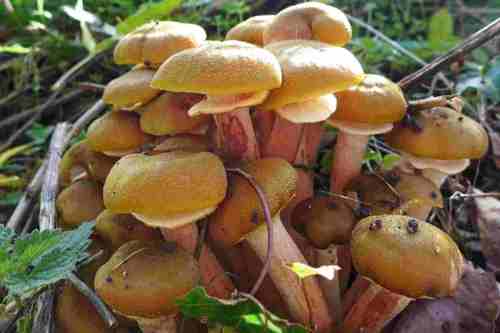
Honey Fungus (Armillaria mellea) © Helena Crouch
We began our foray near the classroom, where some large clumps of Honey Fungus (Armillaria mellea) grew on a bank. As we set off up the road, we were distracted onto grassland by specimens of Shaggy Inkcap (Coprinus comatus), growing with a Stubble Rosegill (Volvopluteus gloiocephala) and Conical Brittlestem (Psathyrella conopilus).
Heading up the drive, we diverted into the woods and found a host of Fairy Inkcaps (Coprinellus disseminatus) on a rotting log. The pretty white caps of these little fungi soon turn a dull grey and begin to blacken. A small specimen beside the log was identified as Bark Bonnet (Mycena speirea) and a group of little white brackets on a twig were the Variable Oysterling (Crepidotus variabilis). Back on the road, we found the familiar sticks of Candlesnuff (Xylaria hypoxylon) on rotting wood on the bank and a crust fungus (Steccherinum fimbriatum) with ramifying pink mycelial cords on a twig. Rather more impressive was the troupe of shining white Ivory Woodwax (Hygrophorus eburneus) on the road bank, growing under Beech trees, with which they are mycorrhizal. Also under Beech trees, we found the Beech Knight (Tricholoma scioides), a grey mycorrhizal fungus with sinuate white gills.
A large old Beech log beside the lane presented us with an array of polyporous bracket fungi: the big white Lumpy Bracket (Trametes gibbosa), common and variably coloured Turkeytail (Trametes versicolor), Blackfoot Polypore (Polyporus leptocephalus) and a smart array of Smoky Bracket (Bjerkandera adusta). At its base was a glorious group of Glistening Inkcap (Coprinellus micaceus), our third inkcap of the day. Many were intrigued by a small spiky jelly fungus emerging from the log: this was the Small Stagshorn (Calocera cornea), another wood-rotting fungus.
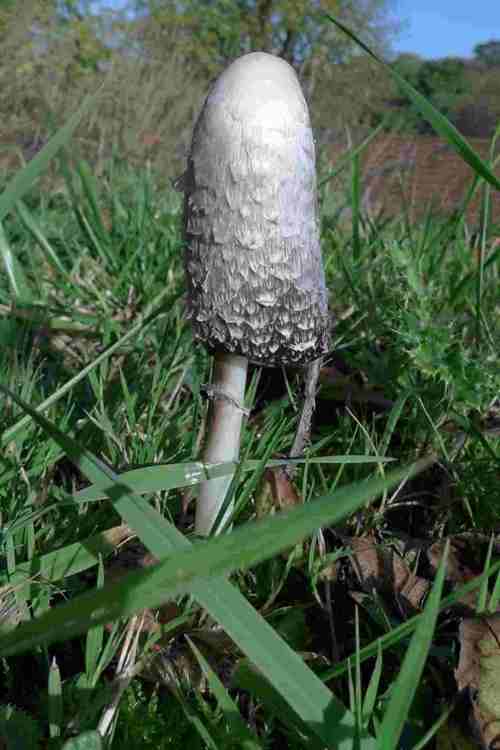
Shaggy Inkcap (Coprinus comatus) © Helena Crouch
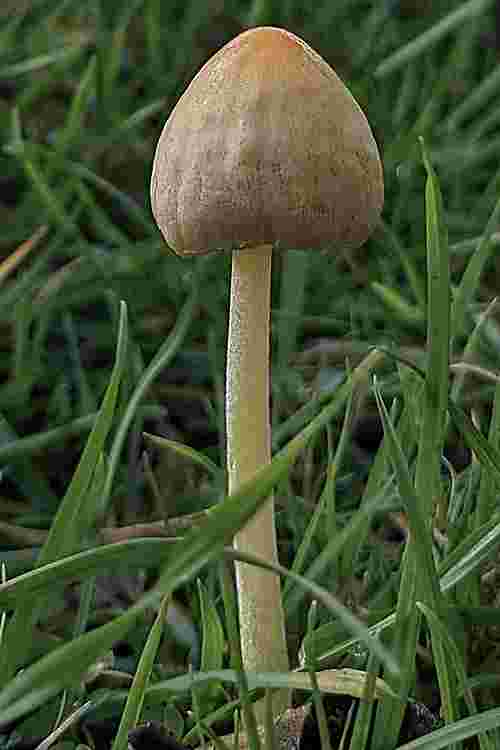
Yellow Fieldcap (Bolbitius titubans) © Helena Crouch
Continuing up the lane, we spotted a host of hundreds of fine long brown needles, each up to 10cm tall, emerging from the bank. These were Slender Clubs (Macrotyphula juncea), growing on leaf litter. Nearby we spotted Pearly Parachutes (Marasmius wynnei), exactly where we found them the previous year. These pretty white fungi also grow on leaf litter, particularly under Beech, as does the dainty Beechleaf Bonnet (Mycena capillaris) and the Wood Woollyfoot (Gymnopus peronatus). Amongst the leaves, we also found a few specimens of Poisonpie (Hebeloma crustuliniforme), a toxic mycorrhizal toadstool with wavy margins to the cap and clay-brown gills.
We returned to the classroom for lunch, generously provided by Penny and Richard, and another opportunity to look at the named specimens. In the afternoon, we explored two contrasting areas of Friary Wood, first heading up a steep slope to the west. Here we soon found Common Bonnet (Mycena galericulata) and an Inky Mushroom (Agaricus moelleri). Alan demonstrated that this is one of the yellow-staining mushrooms which are not edible.
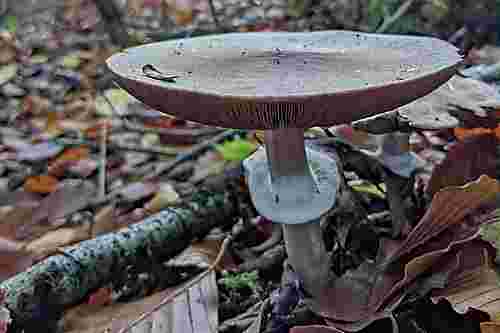
Inky Mushroom (Agaricus moelleri) © Helena Crouch
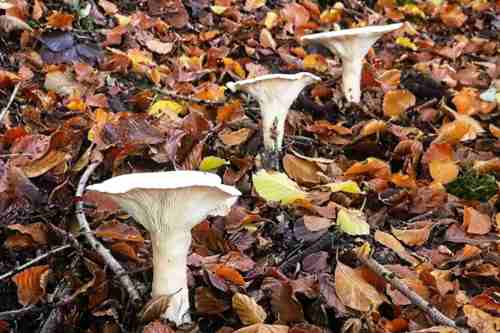
Trooping Funnels (Clitocybe geotropa) © Richard Bottle
Under beech trees we found an arc of statuesque Trooping Funnels (Clitocybe geotropa). The convex caps have a central umbo and the gills are decurrent down the stem. Appropriately for Friary Wood, another name for this species is the Monk’s Head! Nearby was a Bitter Poisonpie (Hebeloma sinapizans), a large brown mycorrhizal fungus smelling of radishes. A single Rooting Shank (Hymenopellis radicata) was seen tucked under a log pile. This tall elegant species can have much of its stem below ground, hence its name. On a log, we added another bracket fungus to our list: the Blushing Bracket (Daedaleopsis confragosa).
Returning to Friary, we headed east across a field, finding White Fibrecap (Inocybe geophylla), a small toxic toadstool, with a silky white cap and grey-brown gills. Entering woodland, we soon found several specimens of the closely related Lilac Fibrecap (Inocybe geophylla var. lilacina): this pretty dainty mycorrhizal fungus is equally toxic. Five different species of Mycena were found in this wood: Milking Bonnet (M. galopus), which exudes a white milky fluid when the stem is snapped; Burgundydrop Bonnet (M. haematopus) which similarly exudes dark red “blood”; Common Bonnet (M. galericulata); Rosy Bonnet (M. rosea) which is poisonous, containing muscarine; and a striking Grooved Bonnet (M. polygramma) with obvious striations on the stem.
Perhaps the cutest species we saw was a little group of Twig Parachutes (Marasmiellus ramealis), tiny white toadstools on a twig. Much more substantial was the mycorrhizal Clouded Funnel (Clitocybe nebularis), a toxic fairy ring species. Beside the path we found several Butter Caps (Rhodocollybia butyracea), with greasy two-tone caps and tough stems. With so many species seen, we were all reaching mycological saturation point, so returned through the field to Friary, finding one of the prettiest fungi of the day, a Yellow Fieldcap (Bolbitius titubans). These short-lived little fungi grow on rotting hay or cow pats, emerging after rain. It seemed that a very large number of species had recently emerged in time for our visit to Friary, making this a most interesting day. Participants were grateful to Penny and Richard for hosting the fungal foray, and to Alan for his informative leadership.
Helena Crouch


Recent Comments